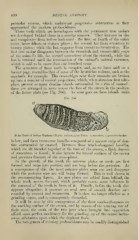Page 480 - My FlipBook
P. 480
490 DENTAL ANATOMY. :
premolar system, which underwent progressive subtraction as they
approached the modern proboscideans.
Three teeth which are homologous with the permanent true molars
are developed behind these in a similar manner. They increase in size
and complexity from before backward : the first, or fourth of the entire
series, bears fifteen or sixteen plates ; the second has from seventeen to
twenty plates ; while the last supports from twenty to twenty-five. The
first true molar disappears between the twentieth and twenty-fifth years
of the animal's life, the second somewhere about the sixtieth, while the
last is retained until the termination of the animal's natural existence,
which is said to be more than one hundred years.
The structure of these teeth is complex, and, as we have said on a
former page, resembles that of some of the hystricine rodents, such as the
capybara, for example. The cross-ridges near their summits are broken
up into a number of conical projections, which, when abrasion first takes
place, present so many dentine islands surrounded by a rim of enamel
these are arranged in rows across the face of the crown in the position
of the future plate (see Fig. 266). As wear goes on these islands unite
Fig. 2G6.
Molar Teeth of Indian Elephant (Elcplms indiciis), after Tomes: a, anterior; /;, posterior border.
below, and form transverse lamellre composed of a narrow strip of den-
tine surrounded by enamel. Between these much-elongated lamellae,
which are all blended together at the base of the crown, a thick deposit
of cementum is found ; it also invests the lateral surfaces of the crown
and prevents fracture of the cross-plates.
In the growth of the tooth the anterior plates or crests are first
formed, and come into ]>osition and use long before the posterior. As
a consequence of this, the most anterior plates wear out and disappear
while the posterior ones are still being formed. This is well shown in
the accompanying figure. As new plates are added from behind, the
whole tooth moves forward, which probably exerts some influence in
the removal of the tooth in front of it. Finally, before the tooth dis-
appears altogether, it ])resents an oval area of smooth dentine sur-
rounded by enamel and cenientum. It is then no longer efficient as a
grinding organ, and is consequently discarded.
It will be seen by this arrangement of the three tooth-substances on
the working surface of the crown, and by reason of the varying rate of
their wear, the teeth of the two jaws when brought into ojiposition
afford most perfect machinery fi)r the grinding up of the coarse herba-
ceous substances upon which the elephant feeds.
The two genera of existing proboscideans may be readily distinguished


